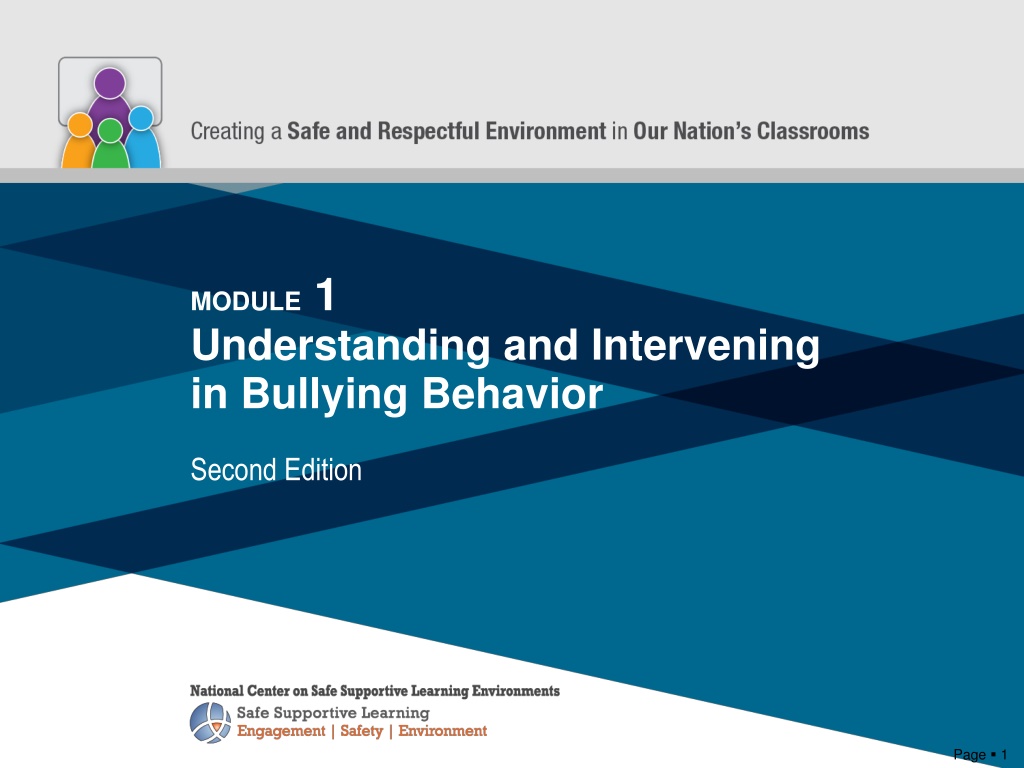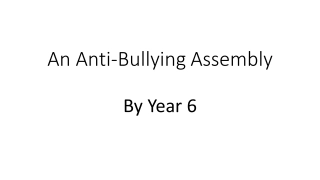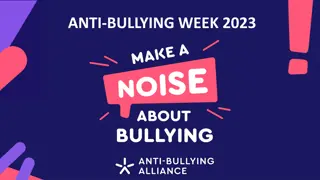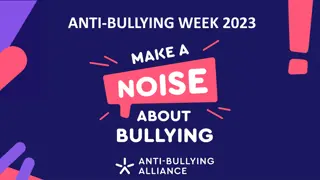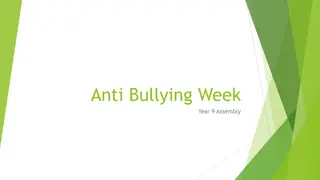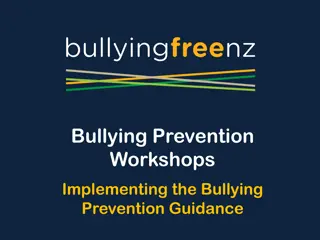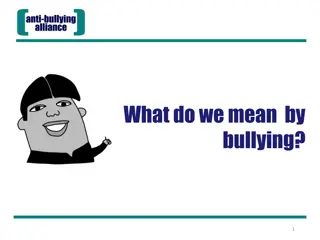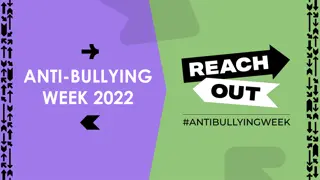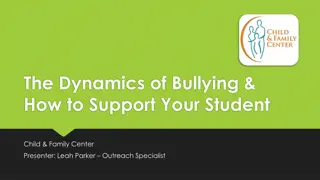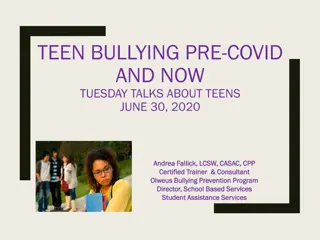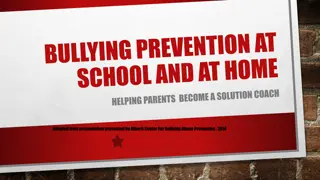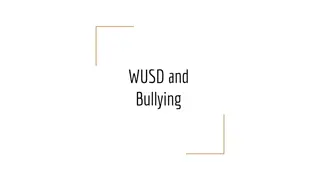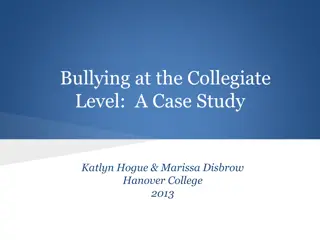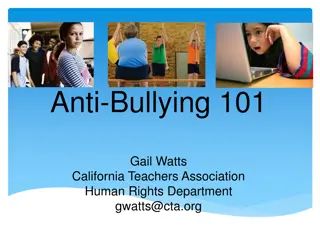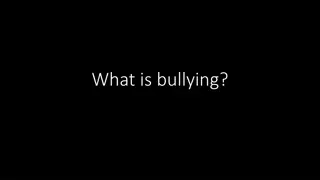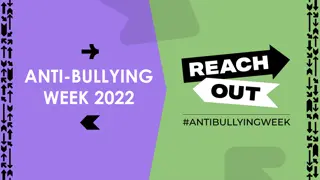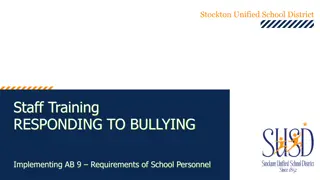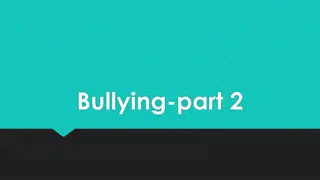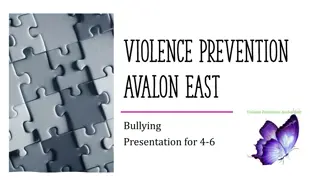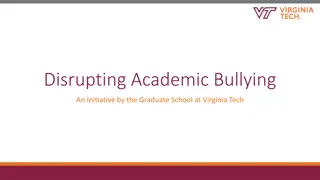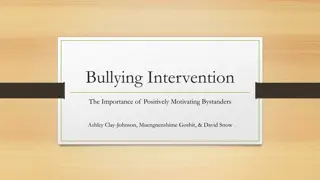Understanding and Intervening in Bullying Behavior - Workshop Insights
This training toolkit delves into the dynamics of bullying behavior, providing insights on identifying, understanding, and responding to it effectively in educational settings. With a focus on creating safe and respectful environments, the content explores the core elements of bullying, the circle of bullying, and practical strategies for intervention.
Download Presentation

Please find below an Image/Link to download the presentation.
The content on the website is provided AS IS for your information and personal use only. It may not be sold, licensed, or shared on other websites without obtaining consent from the author. Download presentation by click this link. If you encounter any issues during the download, it is possible that the publisher has removed the file from their server.
E N D
Presentation Transcript
MODULE 1 Understanding and Intervening in Bullying Behavior Second Edition Page 1
Disclaimer The contents of the Creating a Safe and Respectful Environment in Our Nation s Classrooms training toolkit were designed and written under the U.S. Department of Education (Department) Contract Numbers ED-ESE-12-O-0035 and ED-ESE-16-A-0002 by the National Center on Safe Supportive Learning Environments (NCSSLE) operated by the American Institutes for Research. The content and views expressed herein do not necessarily represent the policies of the Department and should not assume endorsement by the federal government. No official endorsement by the Department of any product, commodity, service, or enterprise mentioned in this publication is intended or should be inferred. For the reader s convenience, this publication contains information about and from outside organizations, including material obtained by way of hyperlinks and URLs. Inclusion of such information does not constitute the Department s endorsement. Second Edition October 2018 This training package is in the public domain. Authorization to reproduce it in whole or in part is granted. While permission to reprint this product is not necessary, the following is the preferred citation: Diamanti, K., Duffey, T., & Fisher, D. (2018). Creating a safe and respectful environment in our nation s classrooms. Washington, DC: National Center on Safe Supportive Learning Environments.
Introductions Your name School Role(s) within your school Your three completed sentence stems Page 3
Workshop Objectives Participants will: Understand what bullying behavior is and is not. Understand what bullying behavior may look like in the classroom. Explore ideas for responding to bullying behavior. Learn to use specific strategies for addressing, reporting, and following up on bullying behavior when it occurs. Page 4
What Is Bullying? Bullying is unwanted, aggressive behavior among students that involves an observed or perceived imbalance of power. The behavior is repeated multiple times or is highly likely to be repeated. Page 5 Citations 3, 15
Core Elements of Bullying Behaviors Bullying includes: Unwanted, aggressive behavior An observed or perceived imbalance of power between the student(s) doing the bullying and the student(s) being bullied Behavior that is repeated multiple times or is highly likely to be repeated Page 6 Citations 3, 15
The Circle of Bullying Students may play a number of different roles in bullying. Direct roles include: - Students who bully - Students who are bullied Students who witness bullying, sometimes called bystanders, can also be affected: - Those who assist - Those who reinforce - Those who remain separate Some students may comfort others who have been bullied or even come to the defense of others. Page 7 Citation 15
A Change in Perspective FROM TO Bully Student who bullies Victim Student who was bullied Behavior is a permanent characteristic. Behavior can be replaced or changed. Page 8
What Do You See? Page 9
What to Look for in Bullying Behavior 1. Unwanted, aggressive behavior 2. An observed or perceived imbalance of power between the student(s) doing the bullying and the student(s) being bullied 3. Behavior that is repeated multiple times or is highly likely to be repeated Page 10 Citations 3, 15
Color Code Red card: Clear example of bullying behavior contains all three elements. Green card: Behavior would concern me but does not rise to the level of bullying. Yellow card: No clear indication based on the scenario I would need to get more information. Page 11
What to Look for in Bullying Behavior 1. Unwanted, aggressive behavior 2. An observed or perceived imbalance of power between the student(s) doing the bullying and the student(s) being bullied 3. Behavior that is repeated multiple times or is highly likely to be repeated Page 12 Citations 3, 15
Types of Bullying Verbal saying or writing mean things Social or relational hurting someone s reputation or relationships Physical hurting a person s body Damage theft, alteration, or damaging personal property, including personal electronic information Page 13 Citations 3, 5, 15
Context for Bullying Bullying can occur within multiple contexts, such as: School and school events Traveling to and from school A student s neighborhood On the Internet Cyberbullying, or electronic bullying, is considered a context or location in which bullying occurs. Page 14 Citations 3, 15
Cyberbullying: Special Concerns Electronic and social media have become so widespread that anyone can post anything about anyone. It can persist because digital devices allow 24-hour access and communication, making it hard for students experiencing it to find relief. It can also become permanent if information isn t found and removed. This can hurt students later when they apply for college admission or jobs. Cyberbullying can take place outside of school and, without policies to address in-school impact, can be harder to address. Page 15 Citations 3, 15
How Often Does Bullying Occur? Nationwide, about 20% of students ages 12 18 said they experienced bullying during the school year. About the same number said they were bullied on school property. Among high school students, an estimated 16% said they were bullied electronically during the school year. Page 16 Citations 2, 13
Forms of Bullying Of the 24 million students surveyed in one year, five million students experienced these forms of bullying: 1. Made fun of, called names or insulted 3,223,000 students 2. Subject of rumors 2,968,000 students 3. Pushed, shoved, tripped, or spit on 1,235,000 students 4. Excluded from activities on purpose 1,220,000 students 5. Threatened with harm 941,000 students 6. Made to do things they did not want to do 607,000 students 7. Property destroyed on purpose 440,000 students Page 17 Citation 13
Students Bullied Because of Perceived Differences Although any student can become a target of bullying, those at heightened risk are often those who are perceived to differ in some way from social norms. This may include perceptions about: 1. The way they look or their body size 2. Whether they are, or people think they are, gay, lesbian, bisexual, transgender, or questioning 3. How masculine or feminine someone thinks they are 4. Their ability in school 5. Their race/ethnicity/national origin and/or religion 6. How much money someone s family may have 7. Youth with disabilities and other special health needs Page 18 Citations 12, 15
Students Most Likely to Be Bullied Females are bullied more than males. Lesbian and bisexual females are bullied more than heterosexual females. Gay and bisexual males are bullied more than heterosexual males. Gay, lesbian, bisexual, and questioning students are bullied more than heterosexual students. Electronic bullying is higher between students who have had sex with each other whether they are the same sex or the opposite sex. Page 19 Citations 2, 4
Impact of Bullying Being involved in bullying in any way can lead to: - Poor school performance, including lower grades and test scores. - Poor classroom attendance. - Negative physical and mental health outcomes, including depression, anxiety, involvement in interpersonal violence or sexual violence, substance use disorder, and poor social functioning. Youth who report any involvement with bullying behavior are more likely to report high levels of suicide-related behavior than youth who do not report any involvement with bullying behavior. - The Centers for Disease Control and Prevention (CDC) says it is correct to say that involvement in bullying, along with other risk factors, increases the chance that a young person will engage in suicide-related behaviors. - Researchers do not know if bullying directly causes suicide-related behavior. Page 20 Citation 1
Possible Indicators of Students Who Bully Get into physical or verbal fights Have friends who bully others Are increasingly aggressive Get sent to the principal s office or detention frequently Have unexplained extra money or new belongings Blame others for their problems Don t accept responsibility for their actions Are competitive and worry about their reputation or popularity Page 21 Citation 15
Common Myths About Students Who Bully Students who bully are loners. Students who bully have low self-esteem and are insecure. Students bully others because they want attention. Bullying behavior is a normal part of kids being kids. Only boys bully others. Page 22 Citations 5, 15
Possible Indicators of Students Who May Be Being Bullied Physical signs like torn, damaged, or soiled clothing; unexplained cuts, bruises, and scratches; missing or damaged items like books or homework without a credible explanation Social isolation, sudden loss of friends, or avoidance of social situations Frequent headaches, stomach aches, feeling sick, or faking illness Changes in eating habits, difficulty sleeping, frequent nightmares Declining grades, loss of interest in schoolwork, or not wanting to go to school Feelings of helplessness or decreased self-esteem Self-destructive behaviors or talking about suicide Page 23 Citations 5, 15
Why Students Dont Ask for Help They might feel helpless, weak, or fear being seen as a tattletale. Students might fear backlash or more bullying. They might feel humiliated and not want adults to know. Students might already feel socially isolated. They might fear being rejected by peers and losing support. Page 24 Citation 7
What Do You See? Page 25
What Does Not Work Group treatment for students who bully Peer mediation and conflict resolution Short-term, one-event approaches Zero tolerance policies Page 26 Citations 5, 15
Address Bullying Behavior 1. Stop the behavior on the spot. 2. Find out what happened. 3. Support the students involved. 4. Report and follow up. Page 27 Citations 10, 15
1. Stop the Behavior on the Spot Stay calm and keep your voice at a normal pitch. Reassure the students involved, including bystanders. If necessary, get another adult to help. Make sure everyone is safe. Separate all participants, preferably to different rooms. Ask the person being targeted, What do you need from me? Meet any immediate medical or mental health needs. Focus on student behavior rather than personalities, reputations, or discipline history. Page 28 Citations 10, 15
When to Get Help A weapon is involved. Someone has been seriously or physically harmed. Threats of serious physical injury have been made. Threats of hate-motivated violence, such as racism or homophobia, have been made. Someone has been sexually abused. Anyone is accused of an illegal act, such as the use of force to get money, property, or services. Someone s valuable property has been destroyed. Page 29 Citation 15
2. Find Out What Happened Was the aggressive behavior actually unwanted? What is the history, including past conflict, between the students involved? Is there a power imbalance? Has this happened before? Is the student who was bullied worried it will happen again? Page 30 Citations 10, 15
3. Support the Students Involved 1. Support the student being bullied. - Listen to, focus on, and ask the student, What do you need from me? - Reassure the student. 2. Support the student engaging in bullying behavior. - Make sure the student knows what the problem behavior is. - Apply consequences in accordance with school policy, and also involve the student in making amends or repairing the situation. 3. Support the bystanders. - Listen to what bystanders have to say about what they have seen. - Reassure bystanders and let them know that you take the situation seriously. Page 31 Citations 5, 10, 15
Turn Down the Heat Maintain control of yourself and your emotions DO Appear calm, centered, and self-assured; use a modulated low tone of voice. Be aware of options. You can leave, tell them to leave, or call for security or the police. Be very respectful even when firmly setting limits or calling for help. DON T Be defensive even if the comments or insults are directed at you. Communicate effectively nonverbally DO Allow extra physical space between you and the aggressor, get to the same eye level, keep your hands out of your pockets to protect yourself, and stand at an angle to the student. DON T Turn your back, stand full front to the student, maintain constant eye contact, point or shake your finger, or laugh. Calm the discussion DO Trust your instincts, empathize with feelings but not with the behavior, suggest alternatives, and explain limits in a firm but respectful tone. DON T Get loud, yell, scream, argue, or analyze. Page 32 Citation 11
4. Report and Follow Up Write down what students say in their own words. If you witness an incident, accurately report what you heard and saw along with what else you learn. Track evidence when you can, such as text messages, photos of damaged property, social media messages, etc. Get copies of everything you can and keep it all in one folder. Fill out reports completely and legibly. Avoid editorial comments like, Suzy is just like her brother. Keep reports confidential and private. Develop a plan for following up with all the students involved. Page 33 Citations 10, 15
Important Reporting Considerations When bullying occurs, reports should indicate whether the conduct included anything that may trigger a school s obligations under civil rights laws that could interfere with their access to education. To help track any hot spots for bullying that should be monitored, the report should include information on: - The identities of the students involved - The location of the incident - The date(s) - Other relevant information that documents patterns involving the same students Schools should have a system for documenting and tracking issues, individual students, and patterns that reveal systemic problems that need to be addressed at a higher level. Page 34 Citation 14
Impact of Trauma on Students Difficulty paying attention and learning. Trouble building relationships with teachers and peers. Spending more time out of class, increasing chances of failing, lower test scores. More likely to be suspended or expelled and have higher rates of referral to special education. Particularly vulnerable groups are at increased risk of being adversely affected by trauma, such as youth who are refugees/immigrants, speak English as a second language, come from high-poverty or low- socioeconomic-status backgrounds, or have a disability. Page 35 Citation 8
Common Symptoms of Trauma Evidence of emotional distress Changes in behavior Changes in social interaction Changes in school performance Page 36 Citations 8, 9
Common Symptoms of Trauma Evidence of emotional distress - Anxiety, fear, worry - Irritability, discomfort, sleep problems, easily startled Changes in behavior - Withdrawal, avoidance - Angry outbursts, increased physical complaints Changes in social interaction - Loss of trust or negative perceptions of others - Increased difficulty interpreting or responding to social cues Changes in school performance - Can t concentrate - Change in work quality or classroom participation Page 37 Citations 8, 9
Reflections What s something you learned in this workshop that affirmedwhat you re already doing in your daily work with students? What s one idea, strategy, or learning that you feel you can apply to improve your skills and/or experience in your role as an educator? Thanks for Participating! Page 38
